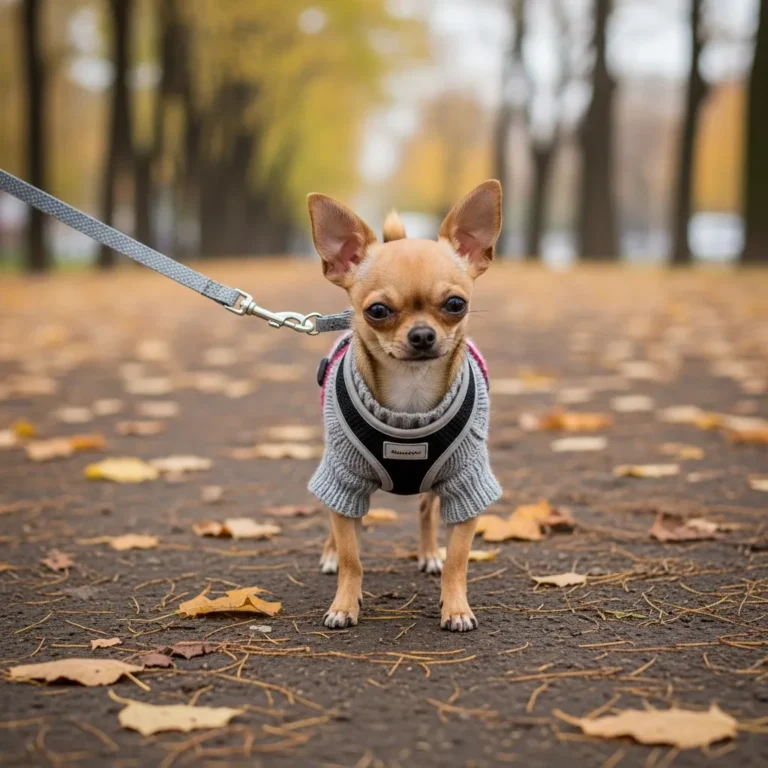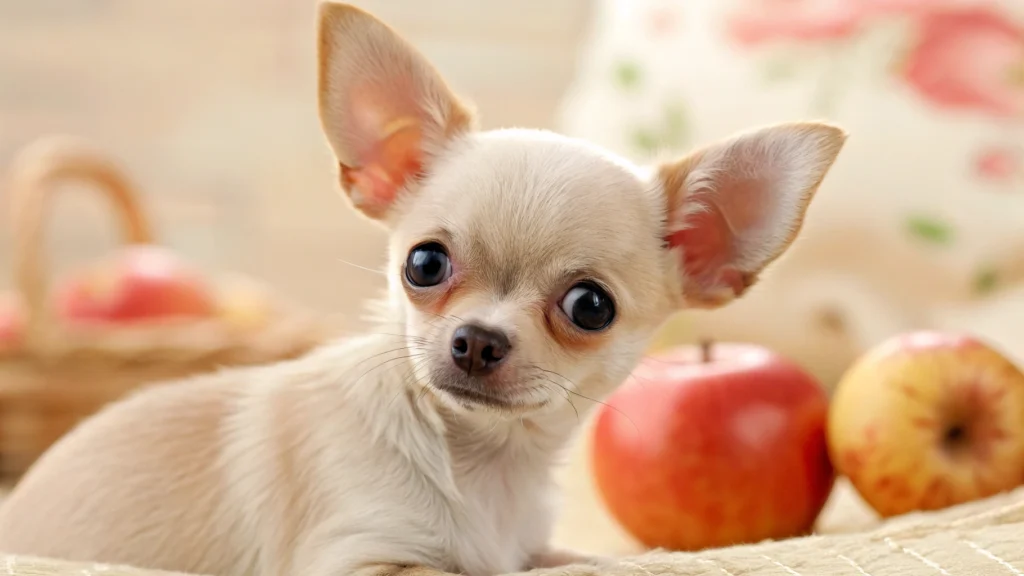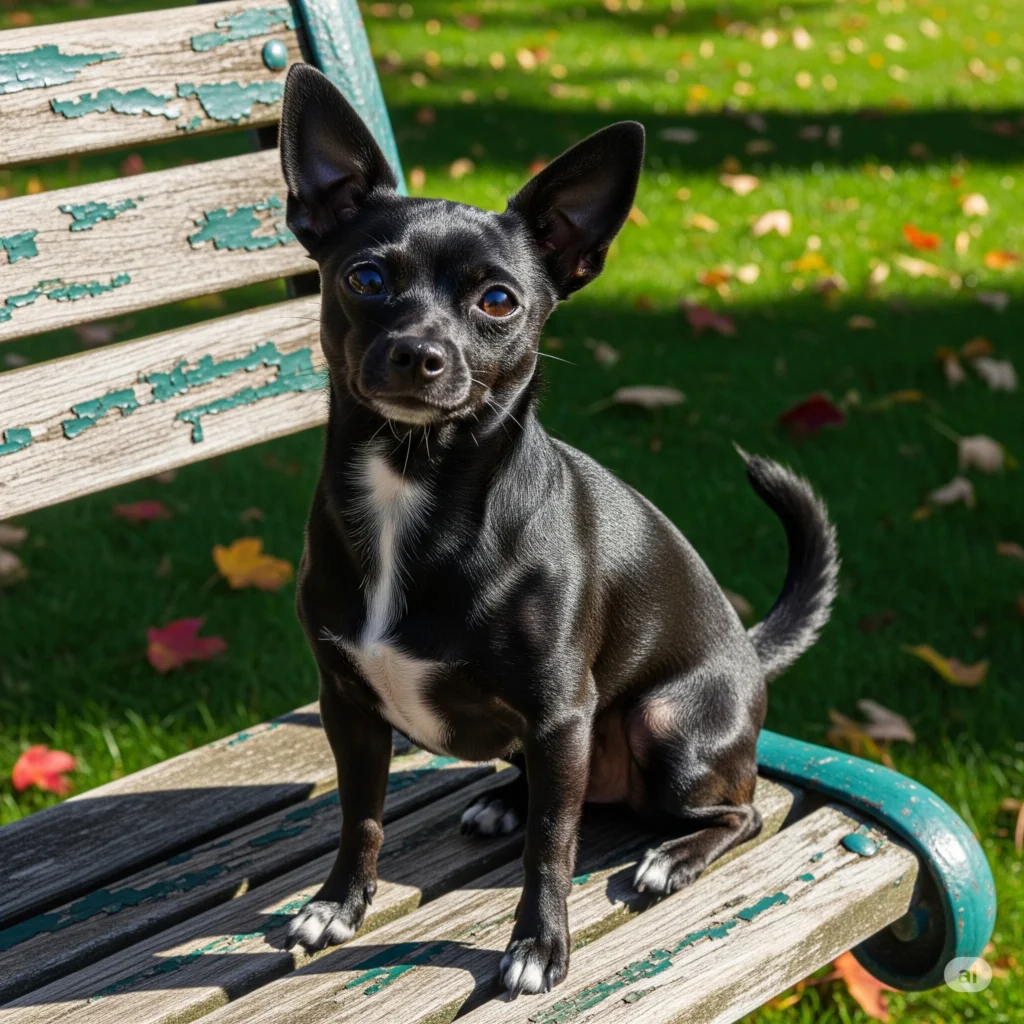
Author: DogsBlogSS Team
⚠️ Disclaimer: This article is for informational purposes only and is not a substitute for consulting a veterinarian.
teacup chihuahua
According to petscare and Dog Leash Pro and petscare+1
There is something undeniably magical about a dog small enough to fit in the palm of your hand. When you scroll through social media and see those wide, saucer-like eyes peering out of a designer handbag or a cozy oversized sweater, it’s hard not to melt. The “Teacup Chihuahua” has become a pop culture icon, a symbol of luxury, and for many, a dream companion.
But here is the reality check that often gets lost in the cute photos: owning a dog the size of a squirrel is a massive responsibility. It isn’t just about buying smaller collars and carrying them around. It involves a completely different approach to canine care, safety, and health.
If you are considering welcoming one of these micro-pups into your life, you probably have a million questions. Are they healthy? Do they bark all day? And perhaps most importantly, do they actually exist as a breed? Let’s grab a coffee (or a tea!) and dive deep into the world of the Teacup Chihuahua, separating the myths from the very tiny, fragile reality.
1. Breed Definition & Identification
The first hurdle in understanding this dog is navigating the terminology. You might be surprised to learn that the term “Teacup” causes quite a stir in the dog world.
Is “Teacup Chihuahua” an officially recognized breed?
Let’s rip the band-aid off right away: No, the “Teacup Chihuahua” is not a breed. If you go to the website of the American Kennel Club (AKC) or look through the breed standards of the United Kennel Club (UKC), you won’t find a category for “Teacup.”
The AKC is very clear on this distinction. They recognize the Chihuahua as a single breed. According to their official breed standard, a Chihuahua should simply not exceed 6 pounds. There is no minimum weight listed, but the club does not endorse a separate “micro” or “teacup” variety. When you see a breeder advertising “Registered Teacup Chihuahuas,” they are technically registering them as standard Chihuahuas that happen to be on the very small side. “Teacup” is purely a marketing adjective—a catchy buzzword used to describe size, not genetics.
What is the difference between a Standard Chihuahua and a Teacup Chihuahua?
According to petscare and Dog Leash Pro and petscare+1:
Since “Teacup” isn’t a separate breed, the difference is strictly physical—specifically, the number on the scale.
Think of it like humans. We have people who are 6 feet tall and people who are 4 feet tall, but they are both humans. A “Standard” Chihuahua typically weighs between 3 and 6 pounds. A dog marketed as a “Teacup” usually falls under the 4-pound mark, with many weighing as little as 2 or 3 pounds fully grown.
important distinction regarding health. While a standard Chihuahua is naturally small, a “Teacup” is often the result of breeding the “runts” (the smallest puppies) of the litter together. While a standard Chihuahua is a sturdy, albeit small, dog, the Teacup variety often possesses a much more delicate constitution purely due to their extreme miniature stature.
How can I tell if a Chihuahua puppy will actually stay “Teacup” sized?
According to petscare and Dog Leash Pro and petscare+1:
This is the million-dollar question, and unfortunately, the answer is: it’s really hard to tell.
Unethical sellers often use a little trickery here. They might sell a puppy that is only 4 or 5 weeks old (which is dangerous and illegal in many places) and claim it is a “Teacup” 8-week-old puppy. Of course, the puppy looks tiny—it’s an infant! Once the dog gets proper nutrition, it might grow to be a standard 6 or 8-pound dog.
Genetics are tricky. Even if both parents are tiny, they might carry genes from a larger grandparent, resulting in a larger puppy. Honest breeders will tell you that they can estimate adult size using growth charts, but they cannot guarantee it. If someone promises you a dog will weigh exactly 2.5 pounds forever, take that as a red flag.
2. Size, Lifespan, and Appearance
When we talk about the physical reality of these dogs, we have to talk about fragility. These aren’t just small dogs; they are anatomically extreme.
How big do Teacup Chihuahuas get when fully grown?
According to petscare and Dog Leash Pro and petscare+1:
When we say small, we mean small. A fully grown Teacup Chihuahua usually stands about 6 inches tall at the shoulder—that is shorter than a standard No. 2 pencil. In terms of weight, they generally top out at 3 to 4 pounds.
To put that in perspective, a gallon of milk weighs about 8.6 pounds. So, a Teacup Chihuahua weighs less than half a gallon of milk. This extreme smallness is why owners have to be hyper-vigilant. A fall from a sofa that a Labrador wouldn’t even notice could be a catastrophic, bone-breaking event for a Teacup.
What is the average life expectancy of a Teacup Chihuahua?
Chihuahuas are famous for being one of the longest-living dog breeds. It is not uncommon to meet a standard Chihuahua who is 15, 17, or even 20 years old.
However, the “Teacup” variety has a slightly different outlook. According to veterinarians at VCA Hospitals, while small dogs generally live longer, “micro” dogs face specific health challenges that can shorten their lifespan. Trauma is a major cause of death—stepping on them or dropping them is a real risk.
That said, if you can navigate the health hurdles and keep them safe from accidents, a Teacup Chihuahua can still live a long life, typically ranging from 12 to 15 years. They are tenacious little survivors, provided they receive high-quality medical care.
Do Teacup Chihuahuas stop growing sooner than standard puppies?
Generally, yes. Because they have less mass to achieve, they tend to reach their full physical frame faster than larger breeds. Most Teacup Chihuahuas will reach their full height by six to eight months of age.
However, they may continue to “fill out” and gain a little muscle weight until they are a year old. It is vital to track their growth carefully. PetMD advises that reliable growth charts can help you track if your puppy is gaining weight appropriately; if a Teacup puppy stops gaining weight too early, it could be a sign of a liver shunt or other metabolic issues, not just them being “naturally small.”
3. Temperament & Compatibility (Lifestyle)
So, they are cute and tiny, but what is it like to actually live with one? The Chihuahua personality is legendary—often described as a big dog in a small package.
Are Teacup Chihuahuas good pets for families with small children?
According to petscare and Dog Leash Pro and petscare+1:
I will be blunt here because the safety of the dog is at stake: generally, no.
Teacup Chihuahuas are not a good match for toddlers or young children. This isn’t because the dog is mean (though they can be snappy if threatened), but because the child is a danger to the dog. A toddler stumbling and falling on a 3-pound dog can be fatal for the pet. A child squeezing the dog too hard in a hug can fracture ribs.
Most reputable breeders and rescue organizations will actually refuse to adopt a Teacup-sized dog to a home with children under the age of 10 or 12. It is too high of a risk. These dogs thrive best in adult-only homes or with calm, older teenagers who understand how to handle them delicately.
Do Teacup Chihuahuas bark a lot?
According to petscare and Dog Leash Pro and petscare+1:
If you want a silent shadow, this might not be the breed for you. Chihuahuas are alert, territorial, and vocal. They take their job as “watchdogs” very seriously, even if they aren’t big enough to back up the threat.
They tend to bark at the doorbell, strange noises, and sometimes just the wind. This is often exacerbated by “Small Dog Syndrome,” where owners let the dog get away with bad behavior because it’s “cute” when a tiny thing growls. Consistent training is key. The American Kennel Club suggests that early socialization can reduce excessive barking, helping the dog feel more confident and less distinctively “yappy” at every new sound.
Are they difficult to potty train compared to larger dogs?
Yes, they can be. This is a matter of biology. A 3-pound dog has a bladder the size of a strawberry. They simply cannot “hold it” for eight hours while you are at work.
Furthermore, because they are so low to the ground, wet grass or snow touches their belly immediately, making them hate going outside in bad weather. Many Teacup owners find success using alternative methods. Indoor potty systems, like pee pads or artificial grass patches in a laundry room, are often the standard for these dogs. It requires patience and consistency, but accepting that they need more frequent breaks than a Golden Retriever is part of the deal.
Can Teacup Chihuahuas get along with other dogs or cats?
This depends entirely on the other animal. A Teacup Chihuahua can be best friends with a gentle, lazy cat. In fact, the cat will often be bigger than the dog!
However, living with large, high-energy dogs can be dangerous. A playful paw swat from a Boxer or a German Shepherd can accidentally cause a concussion or spinal injury to a Teacup. Experts also warn about “predatory drift”—where a larger dog suddenly views the tiny, scurrying Chihuahua as prey (like a squirrel) rather than a pack member. Always supervise interactions, and ensure your larger pets have low prey drives before introducing a Teacup.
4. General Care & Maintenance
According to petscare and dogster:
Caring for a Teacup Chihuahua is less like caring for a dog and more like caring for an infant that never grows up. Their daily needs are specific and non-negotiable.
How often does a Teacup Chihuahua need to eat?
This is perhaps the most critical medical fact to remember. Teacup Chihuahuas have very fast metabolisms and very low reserves of body fat and sugar. They are prone to hypoglycemia (low blood sugar), which can be fatal if not treated immediately.
According to VCA Hospitals, a drop in blood sugar can cause seizures, lethargy, and even death in toy breeds. To prevent this, Teacup Chihuahuas need to eat frequently. While a big dog eats twice a day, a Teacup puppy may need to eat 4 to 6 times a day. Even adults should be fed 3 or 4 small, nutrient-dense meals spaced throughout the day to keep their glucose levels stable. You cannot skip a meal with these dogs.
Do Teacup Chihuahuas need to wear clothes?
According to petmd and American Kennel Club:
You might think dog clothes are just a fashion statement, but for Teacup Chihuahuas, they are a medical necessity. These dogs have a high surface-area-to-body-weight ratio and almost no body fat to keep them warm.
If you see a Chihuahua shivering, they are cold, and chronic cold stress can weaken their immune system. In air-conditioned homes or during winter walks, a sweater is mandatory. PetMD notes that if the temperature drops below 45°F, small dogs are at risk for hypothermia, so bundling up isn’t just cute—it’s survival.
How much exercise does a Teacup Chihuahua actually require?
According to petscare and Dog Leash Pro and petscare+1:
The good news is that you won’t need to train for a marathon. Their legs are tiny! A walk around the block for you is like a 5-mile hike for them.
They do need exercise to keep their hearts healthy and prevent obesity (which is terrible for their tiny joints), but indoor play is often sufficient. Fetching a toy in the living room for 20 minutes often burns off their energy. If you do walk them outside, always use a harness, not a collar. Their tracheas (windpipes) are very fragile and prone to collapsing; pulling on a collar can cause serious damage.
Can you travel easily with a Teacup Chihuahua?
Absolutely. This is the breed’s “superpower.” They fit easily into an airline-approved under-seat carrier. They are generally welcome in many hotels and can accompany you on errands in a tote bag.
However, travel can be stressful. Ensure they have access to water and, crucially, snacks to prevent that blood sugar drop we discussed earlier. But for the globetrotter who wants a companion, they are one of the most portable pets on the planet.
5. Cost, Acquisition, and Controversy
We have arrived at the elephant in the room. Or rather, the mouse in the room. The industry surrounding Teacup puppies is fraught with ethical landmines.
How much does a Teacup Chihuahua puppy cost?
According to Dog Leash Pro:
Prepare for sticker shock. Despite being half the dog, they are often double the price.
Because “Teacup” implies a luxury item and they are difficult to breed (small mothers often require expensive C-sections and have very small litters of 1 or 2 puppies), breeders charge a premium. You can expect to pay anywhere from $2,000 to over $5,000 for a Teacup Chihuahua. Prices can climb even higher for rare coat colors or puppies from “celebrity” bloodlines.
Why is the term “Teacup” considered controversial by many breeders?
According to petscare and Dog Leash Pro and petscare+1:
This is where you need to be a savvy consumer. The Chihuahua Club of America (CCA)—the parent club for the breed in the US—actually condemns the use of the terms “Teacup,” “Pocket,” or “Micro” as marketing gimmicks.
The controversy stems from how the size is achieved. Unethical breeders (often called backyard breeders or puppy mills) will purposefully breed the “runts”—the smallest, often weakest dogs—to create even smaller puppies. This concentrates genetic defects. These dogs are often plagued by hydrocephalus (water on the brain), heart defects, and severe dental issues because their mouths are too small for their teeth. When you buy a “Teacup,” you must be careful that you aren’t funding a breeding program that prioritizes aesthetics over suffering.
What should I look for to ensure a breeder is ethical?
According to petscare and Dog Leash Pro and petscare+1:
If you are set on a very small Chihuahua, you must do your homework to avoid heartache later. Here is what to look for:
- Age of Sale: A reputable breeder will NEVER let a Teacup puppy leave its mother before 10 to 12 weeks of age. Standard puppies might go home at 8 weeks, but Teacups are too fragile.
- Health Guarantees: Look for a breeder who tests parents for heart, eye, and knee (patella) issues and provides proof.
- No “Guaranteed” Weights: An ethical breeder will say, “We expect this puppy to be small,” but will never guarantee a 2-pound adult weight.
- Living Conditions: Always ask to see where the puppies are raised. If the breeder refuses to video chat or let you visit, walk away.
teacup chihuahua for sale
Final Thoughts
The Teacup Chihuahua is a marvel of nature—a spirited, loving, and fiercely loyal soul inside a fragile body. They can be wonderful companions for the right person: someone with a gentle lifestyle, the budget for potential vet bills, and the time to dedicate to their specific feeding and care needs.
They aren’t just accessories; they are living, breathing creatures that require a lot of protection in a world built for giants. If you can provide that safe haven, you’ll have a best friend who might be tiny, but whose love is immeasurable.
Notice : The DogsBlogSS editorial team is dedicated to providing accurate, research-based information about dog health, behavior, and care. All our articles are fact-checked using trusted veterinary sources such as VCA Hospitals, Merck Vet Manual, and the AKC.
you may like it







